|
 |
 |
| |
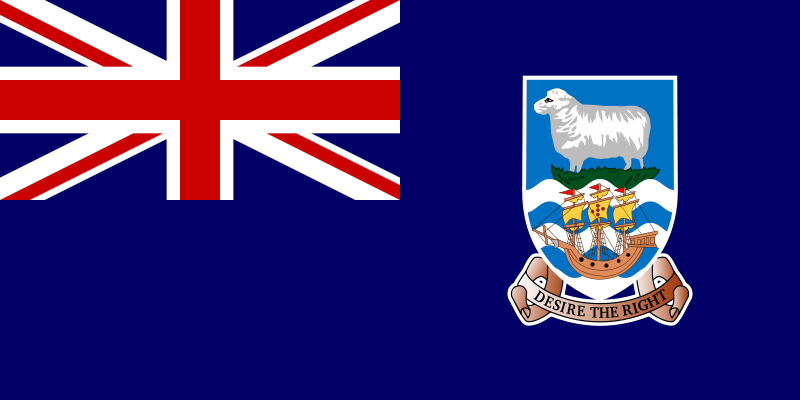 |
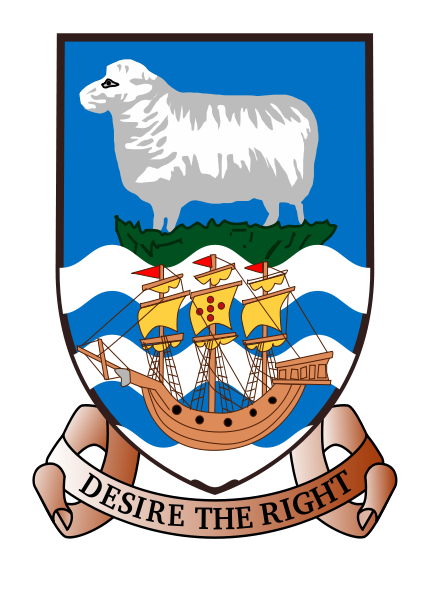 |
| |
| |
14 Aug 1592 First confirmed sighting
of the islands by
English Capt. John Davis (Davis' Land).
Feb 1594 English navigator Richard Hawkins names the islands
Hawkins Maydenlande (Hawkins' Maidenland)
27 Jan 1600 Discovered by Dutch Capt. Sebald de Weert.
27 Jan 1690 First confirmed landing by English Capt. John
Strong.
23 Dec 1708 Named Falkland's Land by Capt. Woode Rogers.
1763 French name the islands the Îles Malouines.
05 Apr 1764 French settlement on East Falkland (Fort St. Louis)
22 Jan 1765 West Falkland Island claimed for Britain by
John
Byron
08 Jan 1766 British settlement on West Falkland (Port Egmont,
Falkland Islands).
01 Apr 1767 French transfer their settlement to Spain.
Puerto de Soledad, named Islas Malvinas.
20 May 1774 Spain forced British to withdraw. British continue to
claim sovereignty over all the Falkland Islands.
Feb 1811 Spanish withdraw.
06 Nov 1820 Argentina claims sovereignty.
1826 Settlement at Port Louis re-established by Frenchman
Louis Vernet who obtains a grant to
all the Falkland
Islands and their resources
from the government of
Argentina.
28 Dec 1831 U.S.S. Lexington under Commander Silas Duncan destroyed
Soledad, and declared the islands
'free of all
government' (this was in response
to Vernet seizing
three American sealing ships).
03 Jan 1833 British depose the Argentine governor.
09 Jan 1834 British occupation.
02 Jan 1842 British civil administration begun.
06 Mar 1892 British crown colony (Falkland Islands).
21 Jul 1908 - 03 Mar 1962 South Shetland Islands, South Orkney Islands and
Graham Land in Antarctica a Falklands dependency
21 Jul 1908 - 03 Oct 1985 South Georgia & South Sandwich Islands a
dependency of
Falkland
Islands.
02 Apr 1982 - 14 Jun 1982 Occupied by Argentina (Islas Malvinas).
03 Oct 1985 - 01 Jan 2009 Former Constitution Order
01 Jan 2009 - date Constitution Order
10 Mar 2013 Planned referendum on sovereignty over islands. |
| |
| |
|
 |
| |
- Repeatedly sighted during the 17th century. The
first unambiguous report was British, from about 1592, and the first known
landing (1690) was also British, but French, Dutch, and Spanish ships were
also aware of its existence.
- France
(only East Falkands)......................05
Apr 1764 - 01 Apr 1767
- Great Britain
(only West Falklands)..............08
Jan 1766 - 10 Jun 1770
- Spain (only
East Falkands).......................01
Apr 1767 - Feb 1811
- Spain briefly took West Falkands from 10 Jun 1770
to 16 Apr 1771.
- Great Britain
(only West Falklands)..............16
Apr 1771 – 20 May 1774
- West Falklands became uninhabited and was claimed
by Spain, while the British claimed the complete Falkland Islands from 1774
to Feb 1811.
-
Uninhabited.........................................Feb 1811 - 06 Nov 1820
-
Argentina........................................06 Nov 1820 - 03 Jan 1833
- Great
Britain....................................03 Jan 1833 - 02 Apr 1982
-
Argentina........................................02 Apr 1982 - 14 Jun 1982
- Argentine military Governor
- Mario Benjamín Menéndez.....................02
Apr 1982 - 14 Jun 1982
- Great
Britain....................................14 Jun 1982 - date
|
| |
| |
| The Falkland
Islands (Spanish: Islas Malvinas) are an archipelago located in the South
Atlantic Ocean on the Patagonian Shelf. The principal islands are about 310
miles (500 kilometres) east of the Patagoinian coast at a latitude of about
52°S. The archipelago which has an area of 4,700 square miles (12,173 square
kilometres) comprises East Falkland, West Falkland and 776 smaller islands.
The islands, a British Overseas Territory, enjoy a large degree of internal
self-government with the United Kingdom guaranteeing good government and
taking responsibility for their defence and foreign affairs. The
capital:
Stanley on East Falkland
(Puerto Argentino Apr-Jun 1982; Port Jackson 1843-Jul 1845; Fort Louis
1833-1843; Puerto Soledad 1767-1833; Fort St. Louis 1764-1767).
Motto: "Desire the right". |
| |
Controversy
exists as to who first discovered the Falkland Islands, with competing
Portuguese, Spanish, and British claims in the 16th century. While
Amerindians from Patagonia could have visited the Falklands, the islands
were uninhabited when discovered by Europeans. The first reliable sighting
is usually attributed to the Dutch explorer Sebald de Weert in 1600, who
named the archipelago the Sebald Islands, a name they bore on Dutch maps
into the 19th century. In 1690, Captain John Strong of the Welfare en route
to Puerto Deseado was driven off course and reached the Falkland Islands
instead, landing at Bold Cove. Sailing between the two principal islands, he
called the passage "Falkland Channel" (now Falkland Sound), after Anthony
Cary, 5th Viscount of Falkland, who as Commissioner of the Admiralty had
financed the expedition. The island group takes its English name from this
body of water. In 1764, French navigator and military commander Louis
Antoine de Bougainville founded the first settlement on Berkeley Sound, in
present-day Port Louis, East Falkland.[19] In 1765, British captain John
Byron explored and claimed Saunders Island on West Falkland, where he named
the harbour Port Egmont and a settlement was constructed in 1766. Unaware of
the French presence, Byron claimed the island group for King George III.
Spain acquired the French colony in 1767, and placed it under a governor
subordinate to the Buenos Aires colonial administration. In 1770, Spain
attacked Port Egmont and expelled the British presence, bringing the two
countries to the brink of war. War was avoided by a peace treaty and the
British return to Port Egmont.
In 1774, economic pressures leading up to the American Revolutionary War
forced Great Britain to withdraw from many overseas settlements. Upon
withdrawal, the British left behind a plaque asserting Britain's continued
claim. Spain maintained its governor until 1806 who, on his departure, left
behind a plaque asserting Spanish claims. The remaining settlers were
withdrawn in 1811. In 1820, storm damage forced the privateer Heroína to
take shelter in the islands. Her captain David Jewett raised the flag of the
United Provinces of the River Plate and read a proclamation claiming the
islands. This became public knowledge in Buenos Aires nearly a year later
after the proclamation was published in the Salem Gazette. After several
failures, Luis Vernet established a settlement in 1828 with authorisation
from the Republic of Buenos Aires and from Great Britain. In 1829, after
asking for help from Buenos Aires, he was instead proclaimed Military and
Civil Commander of the islands. Additionally, Vernet asked the British to
protect his settlement if they returned. A dispute over fishing and hunting
rights resulted in a raid by the US warship USS Lexington in 1831. The log
of the Lexington reports only the destruction of arms and a powder store,
but Vernet made a claim for compensation from the US Government stating that
the settlement was destroyed. Compensation was rejected by the US Government
of President Cleveland in 1885. The islands were declared free from all
government, the seven senior members of the settlement were arrested for
piracy and taken to Montevideo, where they were released without charge on
the orders of Commodore Rogers.
In November 1832, Argentina sent Commander Mestivier as an interim commander
to found a penal settlement, but he was killed in a mutiny after four days.
The following January, British forces returned and requested the Argentine
garrison leave. Don Pinedo, captain of the ARA Sarandi and senior officer
present, protested but ultimately complied. Vernet's settlement continued,
with the Irishman William Dickson tasked with raising the British flag for
passing ships. Vernet's deputy, Matthew Brisbane, returned and was
encouraged by the British to continue the enterprise. The settlement
continued until August 1833, when the leaders were killed in the so-called
Gaucho murders. Subsequently, from 1834 the islands were governed as a
British naval station until 1840 when the British Government decided to
establish a permanent colony.
A new harbour was built in Stanley, and the islands became a strategic point
for navigation around Cape Horn. A World War I naval battle, the Battle of
the Falkland Islands, took place in December 1914, with a British victory
over the smaller Imperial German Asiatic Fleet. During World War II, Stanley
served as a Royal Navy station and serviced ships which took part in the
1939 Battle of the River Plate. Sovereignty over the islands again became an
issue in the second half of the 20th century, when Argentina saw the
creation of the UN as an opportunity to pursue its claim. Talks between
British and Argentine foreign missions took place in the 1960s but failed to
come to any meaningful conclusion. A major sticking point in all the
negotiations was that the inhabitants preferred that the islands remain
British territory. A result of these talks, in 1971, the Argentine state
airline LADE began a service between Comodoro Rivadavia and Stanley. A
temporary strip was followed by the construction of a permanent airfield and
flights between Stanley and Comodoro Rivadavia continued until 1982. Further
agreements gave YPF, the Argentine national oil and gas company, a monopoly
over the supply of the islands energy needs.
On 02 April 1982, Argentina invaded the Falkland Islands and other British
territories in the South Atlantic. By exploiting the long-standing feelings
of Argentines towards the islands, the nation's ruling military junta sought
to divert public attention from Argentina's poor economic performance and
growing internal opposition. Nevertheless, the United Kingdom's reduction of
military capacity in the South Atlantic also encouraged the invasion and won
the war.
The United Kingdom and Argentina both claim responsibility for the Falkland
Islands. The UK bases its position on continuous administration of the
islands since 1833 (apart from 1982) and the islanders having a "right to
self determination, including their right to remain British if that is their
wish". Argentina posits that it gained the Falkland Islands from Spain, upon
becoming independent from it in 1816, and that the UK illegally occupied
them in 1833. Under the British Nationality Act of 1983, Falkland Islanders
are legally British citizens. The islands are a British Overseas Territory
which, under the 2009 Constitution, enjoys a large degree of internal
self-government, with the United Kingdom guaranteeing good government and
taking responsibility for defence and foreign affairs. |
| |
| |
|
Monetary standard:
Falkland Island Pound (FKP or FK£)
= 100 pence. |
| The Falklands
pound has always been pegged to the pound sterling at par and banknotes of
both currencies are used interchangeably on the islands (although only notes
issued by banks in the United Kingdom are generally accepted in Britain
itself). The pound was introduced following the reassertion of sovereignty
in the Falklands Islands by the British in 1833. Initially, the British
currency circulated, with the pound subdivided into 20 shillings, each of 12
pence. Specific issues of banknotes have been made for the Falkland Islands
since 1899. In 1971, the pound was decimalised and subdivided into 100
pence. Circulated coins have been minted specifically for the Falklands since 1974
and Commemorative coin from 1977.
During the earlier Argentine occupation, the peso circulated. In 1974, ½, 1,
2, 5 and 10 pence coins were introduced. 50 pence coins were introduced in
1980, followed by 20 pence in 1982, 1 pound in 1987 and a circulating 2
pounds in 2004. The ½ penny coin was last issued in 1983 and was demonetised
shortly after. Smaller versions of the 5p, 10p and 50p, corresponding to the
current UK issues, were issued in 1998, replacing the larger versions (which
for the 5p was eight years after its introduction in the UK). The
introduction of the circulation £2 coin in 2004 was six years after the same
coin was issued in the UK. All the coins have the same composition and size
as the corresponding British coins. |
| |
|
1980 |
| |
|
 |
|
KM#14.1 50 Pence. Year:
1980. Weight:
13.38g [13.65g]. Metal:
Copper-Nickel. Edge:
Plain. Diameter:
30.00 mm; 7-sided.
Alignment:
Medal. Mint:
British Royal Mint.
Obverse:
Numeral "50" written on the top. Falkland Island fox (extinct since
1876) in the center. "FALKLAND ISLANDS" with date written
at the bottom part.
Reverse:
Queen Elizabeth II portrait facing right in the center with "QUEEN
ELIZABETH THE SECOND" written around her.
Mintage:
N/A.
Minted Years: 1980,
1982, 1983, 1985, 1987, 1992 and 1995.
Engravers:
Arnold Machin (Queen Elizabeth side) and William Maving Gardner
(value side). |
|
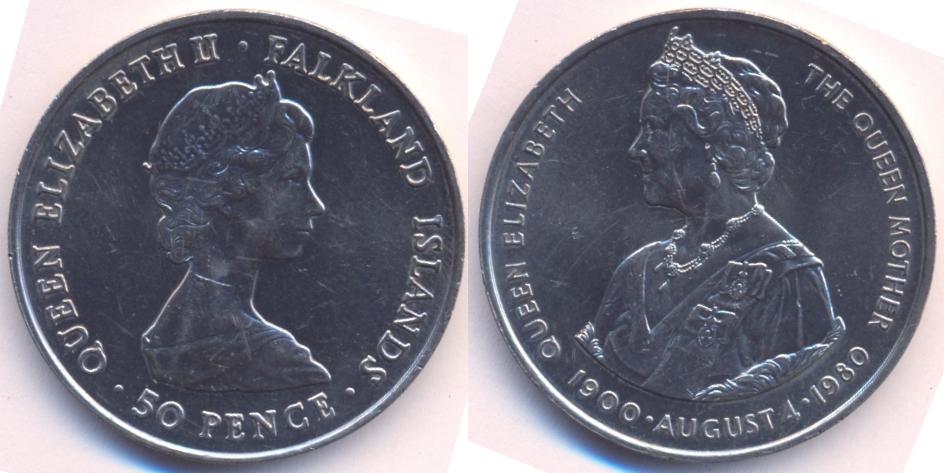 |
| KM#15 50 pence. Year:
ND (1980). Weight:
28.26g [28.28g]. Metal:
Copper-Nickel. Edge:
Reeded. Diameter:
38.50 mm.
Alignment:
Medal. Mint:
British Royal Mint.
Obverse:
Queen Elizabeth II portrait facing right in the center with "· QUEEN
ELIZABETH II · FALKLAND ISLANDS ·" written around her. Value "50 PENCE"
at the bottom.
Reverse:
Queen Elizabeth, The Queen's Mother
portrait in facing left. "QUEEN ELIZABETH" written on the left side
clockwise and "THE QUEEN MOTHER" written on the right side
clockwise. "1900 · AUGUST 4 · 1980" written at the bottom.
Mintage:
46,673.
Minted Years: One year
type. Note:
This coin also exits in 0.925 silver as KM#15a (Mintage: 8,609) with same
weight and diameter. Elizabeth Angela Marguerite Bowes-Lyon (04 August 1900 – 30 March
2002) was the wife of King George VI and the mother of Queen
Elizabeth II. She was queen consort of the United Kingdom from her
husband's accession in 1936 until his death in 1952, after which she
was known as Queen Elizabeth The Queen Mother, to avoid confusion
with her daughter. |
|
| |
|
1983 |
| |
|
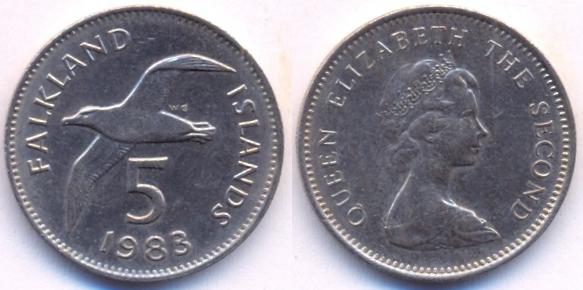 |
KM#4.1 5 Pence. Year:
1983. Weight:
5.64g [5.65g]. Metal:
Copper-Nickel. Edge:
Reeded. Diameter:
23.60 mm.
Alignment:
Medal. Mint:
British Royal Mint.
Obverse:
Blackbrowed albatross in flight in the center with numeral "5" below
it. "FALKLAND" written on the left side clockwise and "ISLANDS" on
the right side clockwise. Year at the bottom. |
|
Reverse:
Queen Elizabeth II portrait facing right in the center with "QUEEN
ELIZABETH THE SECOND" written around her.
Mintage:
N/A.
Minted Years: 1974, 1980,
1982, 1983, 1985, 1987 and 1992. Engravers:
Arnold Machin (Queen Elizabeth side) and William Maving Gardner
(value side). |
|
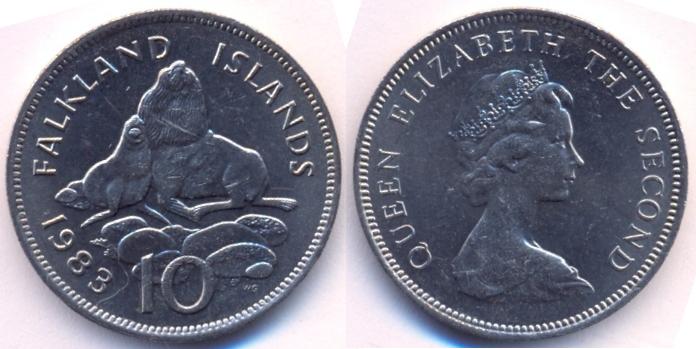 |
KM#5.1 10 Pence. Year:
1983. Weight:
11.41g [11.31g]. Metal:
Copper-Nickel. Edge:
Reeded. Diameter:
28.50 mm.
Alignment:
Medal. Mint:
British Royal Mint.
Obverse:
"FALKLAND ISLANDS" written on the top. Ursine seal with cub in the
center and numeral "10" below it. Year at the bottom left side.
Reverse:
Queen Elizabeth II portrait facing right in the center with "QUEEN
ELIZABETH THE SECOND" written around her.
Mintage:
N/A.
Minted Years: 1974, 1980,
1982, 1983, 1985, 1987 and 1992. |
|
Engravers:
Arnold Machin (Queen Elizabeth side) and William Maving Gardner
(value side). |
|
| |
|
1992 |
| |
|
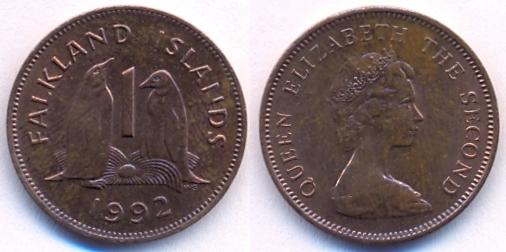 |
KM#2 1 Penny. Year:
1992. Weight:
3.52g [3.56g]. Metal:
Bronze. Edge:
Plain. Diameter:
20.32 mm.
Alignment:
Medal. Mint:
British Royal Mint.
Obverse:
"FALKLAND ISLANDS" written above. Two Gentoo penguins in the center
with numeral "1" between them. Year at the bottom. |
|
Reverse:
Queen Elizabeth II portrait facing right in the center with "QUEEN
ELIZABETH THE SECOND" written around her.
Mintage:
N/A.
Minted Years: 1974, 1980,
1982, 1983, 1985, 1987 and 1992. Engravers:
Arnold Machin (Queen Elizabeth side) and William Maving Gardner
(value side). |
|
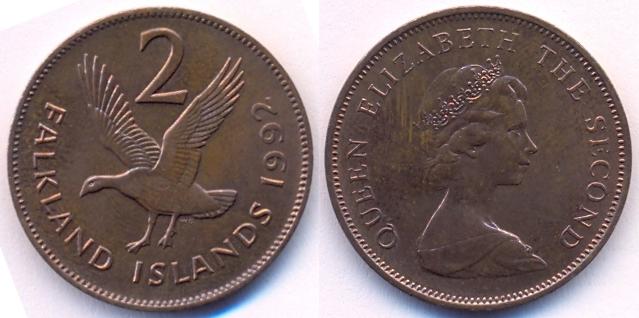 |
KM#3 2 Pence. Year:
1992. Weight:
7.08g [7.12g]. Metal:
Bronze. Edge:
Plain. Diameter:
25.90 mm.
Alignment:
Medal. Mint:
British Royal Mint.
Obverse:
Numeral "2" at the top. Upland goose (Magellan Goose) with opened wings in the center.
"FALKLAND ISLANDS" written below. Year on the right side. |
|
Reverse:
Queen Elizabeth II portrait facing right in the center with "QUEEN
ELIZABETH THE SECOND" written around her.
Mintage:
N/A.
Minted Years: 1974, 1980,
1982, 1983, 1985, 1987 and 1992. Engravers:
Arnold Machin (Queen Elizabeth side) and William Maving Gardner
(value side). |
|
 |
KM#4.1 5 Pence. Year:
1992. Weight:
5.68g [5.65g]. Metal:
Copper-Nickel. Edge:
Reeded. Diameter:
23.60 mm.
Alignment:
Medal. Mint:
British Royal Mint.
Obverse:
Blackbrowed albatross in flight in the center with numeral "5" below
it. "FALKLAND" written on the left side clockwise and "ISLANDS" on
the right side clockwise. Year at the bottom. |
|
Reverse:
Queen Elizabeth II portrait facing right in the center with "QUEEN
ELIZABETH THE SECOND" written around her.
Mintage:
N/A.
Minted Years: 1974, 1980,
1982, 1983, 1985, 1987 and 1992.
Engravers:
Arnold Machin (Queen Elizabeth side) and William Maving Gardner
(value side). |
|
 |
KM#17 20 Pence. Year:
1992. Weight:
5.08g [5.00g]. Metal:
Copper-Nickel. Edge:
Plain. Diameter:
21.95 mm; 7-sided.
Alignment:
Medal. Mint:
British Royal Mint.
Obverse:
Numeral "20" at the top. Romney marsh sheep facing left in the center.
"FALKLAND ISLANDS" written below. Year on the right side.
Reverse:
Queen Elizabeth II portrait facing right in the center with "QUEEN
ELIZABETH THE SECOND" written around her.
Mintage:
N/A.
Minted Years: 1982, 1983,
1985, 1987, 1992, 1998 and 1999. |
|
Note: The Romney, formerly called the
Romney Marsh sheep is also found on Falkland Island's flag and Coat
of Arms. The Romney is an economically-important sheep breed,
especially to the sheep-meat and wool export trades. They are found
in abundance in Kent, England and New Zealand as well. Romneys are
said to be somewhat resistant to foot rot, liver flukes and other
problems that often plague sheep in damp pastures.
Engravers: Arnold Machin (Queen Elizabeth side)
and Robert
Elderton (value side). |
|
 |
|
KM#34 50 pence. Year:
ND (1992). Weight:
28.23g [28.28g]. Metal:
Copper-Nickel. Edge:
Reeded. Diameter:
38.50 mm.
Alignment:
Medal. Mint:
British Royal Mint.
Obverse:
Queen Elizabeth II portrait facing right in the center with "· QUEEN
ELIZABETH II · FALKLAND ISLANDS ·" written around her. Value "50 PENCE"
at the bottom.
Reverse:
Three figures standing, one at left is silhouette. "40th ANNIVERSARY
OF REIGN 1952-1992" written on the left side clockwise.
Mintage:
N/A.
Minted Years: One year
type. Subject:
40th Anniversary - Reign of Queen Elizabeth II.
Engravers:
Raphael David Maklouf (Queen Elizabeth side) and Willem Vis (Three
figure standing side). Note:
This coin also exits in 0.925 silver as KM#34a (Mintage: 5,000) with same
weight and diameter and in 0.916 gold as KM#34b (Mintage: 150) with
weight 47.54g with same diamater. |
|
| |
|
1998 |
| |
|
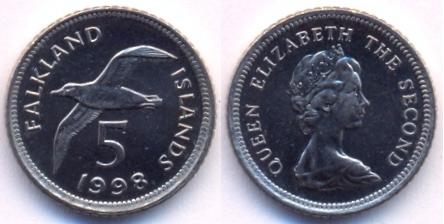 |
KM#4.2 5 Pence. Year:
1998. Weight:
3.23g [3.25g]. Metal:
Copper-Nickel. Edge:
Reeded. Diameter:
18.00 mm.
Alignment:
Medal. Mint:
British Royal Mint.
Obverse:
Blackbrowed albatross in flight in the center with numeral "5" below
it. "FALKLAND" written on the left side clockwise and "ISLANDS" on
the right side clockwise. Year at the bottom. |
|
Reverse:
Queen Elizabeth II portrait facing right in the center with "QUEEN
ELIZABETH THE SECOND" written around her.
Mintage:
N/A.
Minted Years: 1998 and 1999.
Engravers:
Arnold Machin (Queen Elizabeth side) and William Maving Gardner
(value side). |
|
 |
KM#17 20 Pence. Year:
1998. Weight:
4.96g [5.00g]. Metal:
Copper-Nickel. Edge:
Plain. Diameter:
21.95 mm; 7-sided.
Alignment:
Medal. Mint:
British Royal Mint.
Obverse:
Numeral "20" at the top. Romney marsh sheep facing left in the center.
"FALKLAND ISLANDS" written below. Year on the right side.
|
|
Reverse:
Queen Elizabeth II portrait facing right in the center with "QUEEN
ELIZABETH THE SECOND" written around her.
Mintage:
N/A.
Minted Years: 1982, 1983,
1985, 1987, 1992, 1998 and 1999.
Engravers: Arnold Machin (Queen Elizabeth side)
and Robert
Elderton (value side). |
|
| |
|
1999 |
| |
|
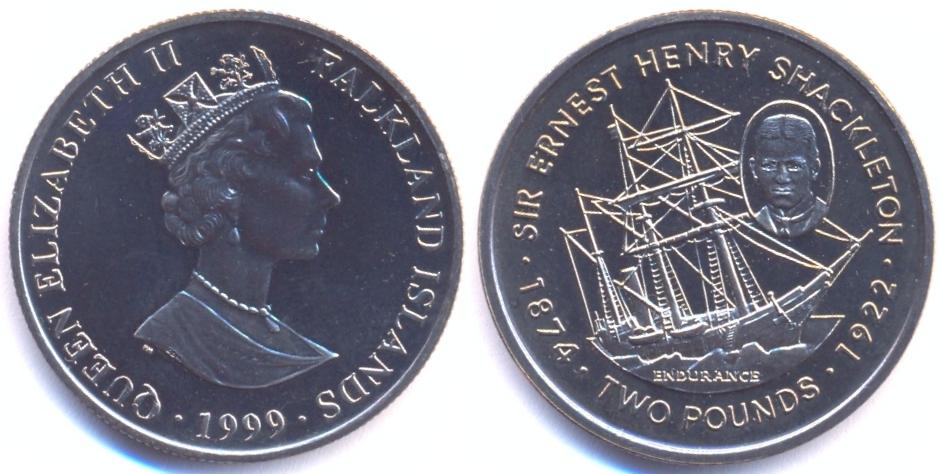 |
| KM#64 2 Pounds. Year:
1999. Weight:
28.58g [28.28g]. Metal:
Copper-Nickel. Edge:
Reeded. Diameter:
38.60 mm.
Alignment:
Medal. Mint:
Pobjoy Mint.
Obverse: Queen Elizabeth II's portrait facing
right in the center. "QUEEN ELIZABETH II FALKLAND ISLANDS"
written around her. Year at the bottom.
Reverse:
"SIR ERNEST HENRY SHACKLETON" written on the top. Endurance Ship
in the center.
Sir E. H. Shackleton's face in oval in center right side. Year
"1874" written on the bottom left side and Year "1922" written on
the bottom right side. Value
"TWO POUNDS" at the bottom. Mintage:
981.
Minted Years: One year
type. Note:
This coin also exits in 0.925 silver as KM#64a (Mintage: 2,322)
with same weight and diameter.
In April 1916, Ernest Shackleton's Imperial
Trans-Antarctic Expedition became stranded on Elephant Island, some
800 miles (1,300 km) southwest of South Georgia. Shackleton and five
companions set out in a small boat to summon help, and on 10 May,
after an epic voyage, they landed at King Haakon Bay on South
Georgia's south coast. While three stayed at the coast, Shackleton
and the two others, Tom Crean and Frank Worsley, went on to cover 22
miles (35 km) overland to reach help at Stromness whaling station.
The remaining 22 members of the expedition, who had stayed on
Elephant Island, were subsequently rescued. In January 1922, during
a later expedition, Shackleton died on board ship while moored in
King Edward Cove, South Georgia. He is buried at Grytviken. |
|
| |
|
2000 |
| |
|
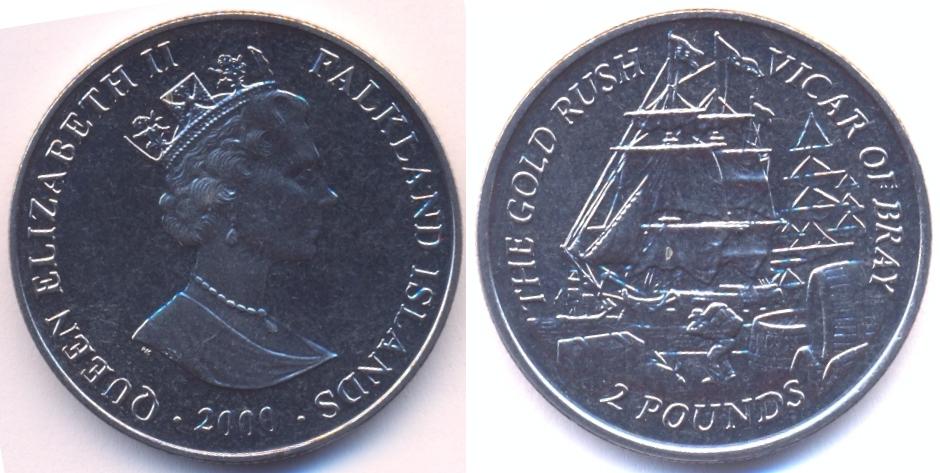 |
| KM#67 2 Pounds. Year:
2000. Weight:
28.42g [28.28g]. Metal:
Copper-Nickel. Edge:
Reeded. Diameter:
38.60 mm.
Alignment:
Medal. Mint:
Pobjoy Mint.
Obverse: Queen Elizabeth II's portrait facing
right in the center. "QUEEN ELIZABETH II FALKLAND ISLANDS"
written around her. Year at the bottom.
Reverse:
"THE GOLD RUSH VICAR OF BRAY" written on the top. Ship at the
harbor with a person carrying goods on this back. Value
"TWO POUNDS" at the bottom. Mintage:
914.
Minted Years: One year
type. Note:
This coin also exits in silver as KM#67a (Mintage: 1010) with same
weight and diameter. |
|
 |
| KM#69a 2 Pounds. Year:
1999-2000 (Millennium issue). Weight:
28.15g [28.10g]. Metal:
0.925 Silver; Bi-Metallic, Silver in center and
in Gold-plated Silver in outer ring. Edge:
Reeded. Diameter:
38.61 mm.
Alignment:
Medal. Mint:
British Royal Mint.
Obverse: Queen Elizabeth II's portrait facing
right in the center. "QUEEN ELIZABETH II · FALKLAND ISLANDS"
written around her. Year "· 1999 · 2000 ·" at the bottom.
Reverse:
Islands map, radiant
sun, and denomination "TWO POUNDS" within circle of local wildlife. Mintage:
3,655.
Minted Years: One year
type. Designer:
Raphael Maklouf (Queen Elizabeth side) and Mathew Bonaccorsi (value side). Note:
This coin also exits as KM#69 (Mintage: 3,419) in
Copper-Nickel center and Nickel-Brass in outer ring. Plain edge with
28.28g weight and 38.61 mm diameter. |
|
| |
|
2004 |
| |
|
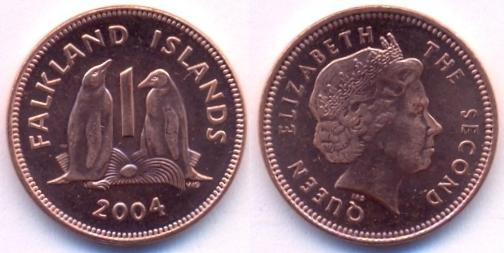 |
KM#130 1 Penny. Year:
2004. Weight:
3.54g [3.56g]. Metal:
Bronze plated steel. Edge:
Plain. Diameter:
20.32 mm.
Alignment:
Medal. Mint:
British Royal Mint.
Obverse:
"FALKLAND ISLANDS" written above. Two Gentoo penguins in the center
with numeral "1" between them. Year at the bottom. |
|
Reverse:
Queen Elizabeth II portrait facing right in the center with "QUEEN
ELIZABETH THE SECOND" written around her.
Mintage:
N/A.
Minted Years: 2004 and
2011. Engravers:
Ian Rank-Broadley (Queen Elizabeth side) and William Maving Gardner
(value side). |
|
 |
KM#131 2 Pence. Year:
2004. Weight:
7.12g [7.12g]. Metal:
Bronze. Edge:
Plain. Diameter:
25.90 mm.
Alignment:
Medal. Mint:
British Royal Mint.
Obverse:
Numeral "2" at the top. Upland goose (Magellan Goose) with opened wings in the center.
"FALKLAND ISLANDS" written below. Year on the right side.
Reverse:
Queen Elizabeth II portrait facing right in the center with "QUEEN
ELIZABETH THE SECOND" written around her.
Mintage:
N/A.
Minted Years: 2004 and
2011. |
|
Engravers:
Ian Rank-Broadley (Queen Elizabeth side) and William Maving Gardner
(value side). |
|
 |
KM#133a 10 Pence. Year:
2004. Weight:
6.48g [6.50g]. Metal:
Copper
Clad Steel. Edge:
Reeded. Diameter:
24.50 mm.
Alignment:
Medal. Mint:
British Royal Mint.
Obverse:
"FALKLAND ISLANDS" written on the top. Ursine seal with cub in the
center and numeral "10" below it. Year at the bottom left side. |
|
Reverse:
Queen Elizabeth II portrait facing right in the center with "QUEEN
ELIZABETH THE SECOND" written around her.
Mintage:
N/A.
Minted Years: One year
type. Engravers:
Arnold Machin (Queen Elizabeth side) and William Maving Gardner
(value side). Note:
Falkland used the old dies for striking new magnetic coins.
Therefore 5 Pence 2011 and 10 Pence 2004 exist in non magnetic and
magnetic versions. |
|
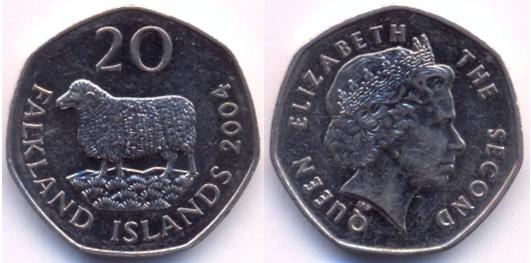 |
KM#134 20 Pence. Year:
2004. Weight:
5.15g [5.00g]. Metal:
Copper-Nickel. Edge:
Plain. Diameter:
21.95 mm; 7-sided.
Alignment:
Medal. Mint:
British Royal Mint.
Obverse:
Numeral "20" at the top. Romney marsh sheep facing left in the center.
"FALKLAND ISLANDS" written below. Year on the right side.
Reverse:
Queen Elizabeth II portrait facing right in the center with "QUEEN
ELIZABETH THE SECOND" written around her.
Mintage:
N/A.
Minted Years: One year
type. |
|
Engravers: Ian Rank-Broadley (Queen Elizabeth side)
and Robert
Elderton (value side). |
|
 |
KM#137 2 Pounds. Year:
2004. Weight:
11.99g [12.00g]. Metal:
Bi-Metallic; Copper-nickel center and
Nickel-brass ring.
Edge:
Reeded and Lettering "30 YEARS OF FALKLAND ISLANDS
COINAGE ·". Diameter:
28.40 mm.
Thickness: 2.50 mm.
Alignment:
Medal. Mint:
British Royal Mint. |
|
Obverse: Queen Elizabeth II's portrait facing
right in the center. "QUEEN ELIZABETH THE SECOND"
written around her. Year "2004" at the bottom.
Reverse:
"FALKLAND ISLANDS" written at the top within inner circle.
Islands map, radiant
sun, and denomination "TWO POUNDS" at the bottom within circle.
Various local wildlife in outer circle. Mintage:
N/A.
Minted Years: 2003 and
2004.
Engravers:
Ian Rank-Broadley (Queen Elizabeth side) and Mathew Bonaccorsi (value
side). |
|
| |
|
2011 |
| |
|
 |
KM#130 1 Penny. Year:
2011. Weight:
3.54g [3.56g]. Metal:
Bronze plated steel. Edge:
Plain. Diameter:
20.32 mm.
Alignment:
Medal. Mint:
British Royal Mint.
Obverse:
"FALKLAND ISLANDS" written above. Two Gentoo penguins in the center
with numeral "1" between them. Year at the bottom. |
|
Reverse:
Queen Elizabeth II portrait facing right in the center with "QUEEN
ELIZABETH THE SECOND" written around her.
Mintage:
N/A.
Minted Years: 2004 and
2011. Engravers:
Ian Rank-Broadley (Queen Elizabeth side) and William Maving Gardner
(value side). |
|
 |
KM#131 2 Pence. Year:
2011. Weight:
7.04g [7.12g]. Metal:
Bronze. Edge:
Plain. Diameter:
25.90 mm.
Alignment:
Medal. Mint:
British Royal Mint.
Obverse:
Numeral "2" at the top. Upland goose (Magellan Goose) with opened wings in the center.
"FALKLAND ISLANDS" written below. Year on the right side.
|
|
Reverse:
Queen Elizabeth II portrait facing right in the center with "QUEEN
ELIZABETH THE SECOND" written around her.
Mintage:
N/A.
Minted Years: 2004 and
2011. Engravers:
Ian Rank-Broadley (Queen Elizabeth side) and William Maving Gardner
(value side). |
|
 |
KM#132 5 Pence. Year:
2011. Weight:
3.18g [3.25g]. Metal:
Copper
Nickel. Edge:
Reeded. Diameter:
18.00 mm.
Alignment:
Medal. Mint:
British Royal Mint.
Obverse:
Blackbrowed albatross in flight in the center with numeral "5" below
it. "FALKLAND" written on the left side clockwise and "ISLANDS" on
the right side clockwise. Year at the bottom. |
|
Reverse:
Queen Elizabeth II portrait facing right in the center with "QUEEN
ELIZABETH THE SECOND" written around her.
Mintage:
N/A.
Minted Years: 2004 and
2011.
Engravers:
Ian Rank-Broadley (Queen Elizabeth side) and William Maving Gardner
(value side). Note:
Falkland used the old dies for striking new magnetic coins.
Therefore 5 Pence 2011 and 10 Pence 2004 exist in non magnetic and
magnetic versions. |
|
 |
Same as above coin, but... KM#132s 5 Pence. Year:
2011. Weight:
3.21g [3.25g]. Metal:
Copper
Clad Steel. |
|
| |
|
2014 |
| |
|
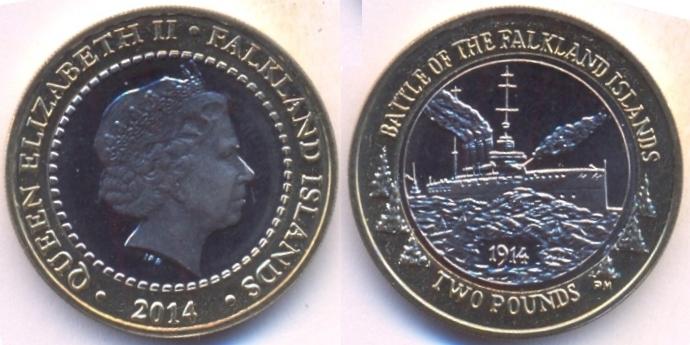 |
2 Pounds. Year:
2014. Weight:
12.02g [12.00g]. Metal:
Bi-Metallic; Copper-nickel center and
Nickel-brass ring.
Edge:
Reeded. Diameter:
28.40 mm.
Thickness: 2.50 mm.
Alignment:
Medal. Mint:
British Royal Mint. |
|
Obverse: Queen Elizabeth II's portrait facing
right in the center. "QUEEN ELIZABETH THE SECOND"
written around her. Year "2014" at the bottom.
Reverse:
"BATTLE OF THE FALKLAND ISLANDS" written at the top. Ship
firing missiles within inner circle. "TWO POUNDS" at the bottom.
Three smaller ships on each side in outer circle. Mintage:
N/A.
Minted Years: 2003 and
2004.
Engravers:
Ian Rank-Broadley (obverse side). |
|
| |
| |
| |
|
|
|
|
Countries
/ Territories |
| |
|
Chiefa Coins |
|
|




























